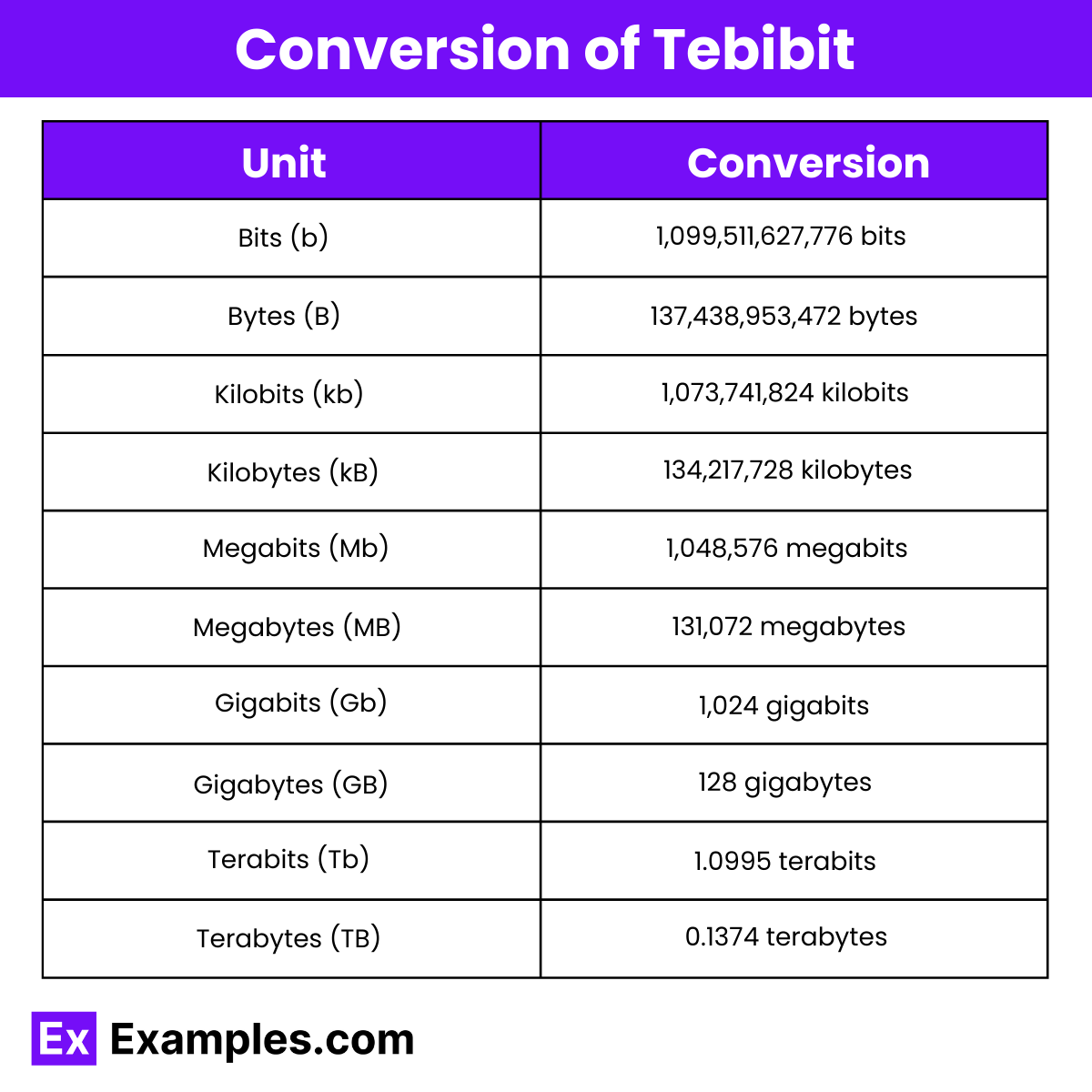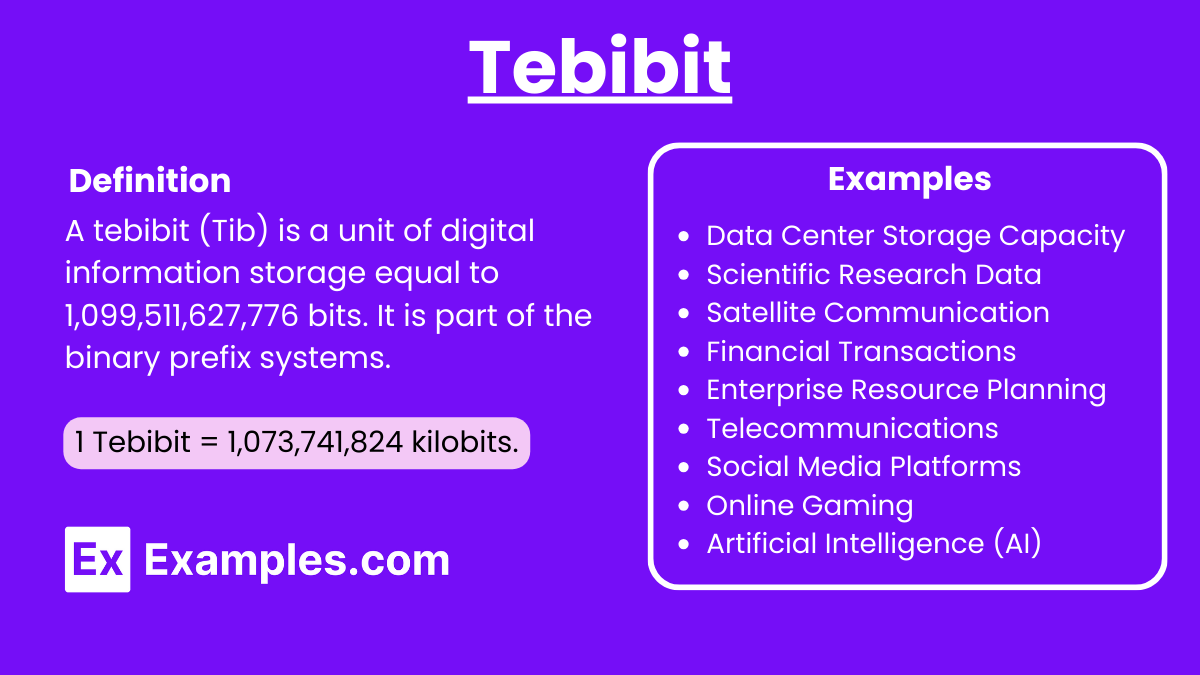Tebibit – 20 Examples, Conversion Chart, Uses
A tebibit (TiB) is a unit of digital information storage, commonly used in cloud computing and digital communication. Representing 2^40 bits, or 1,099,511,627,776 bits, it is larger than a terabit. Tebibits are crucial in communication technology, especially when dealing with large data transfers and high-capacity storage solutions. Understanding tebibits is essential for professionals in fields relying heavily on efficient data management and storage.
What is Tebibit?
A tebibit (Tibit) is a unit of digital information storage equivalent to 1,099,511,627,776 bits. It is commonly used in fields requiring precise data measurement, such as computer science and digital communication.
Examples of Tebibit
- Data Center Storage Capacity: Large data centers use tebibits (Tibit) to measure their extensive storage capabilities.
- High-Resolution Video Streaming: Streaming services can transfer high-definition and 4K videos measured in tebibits.
- Scientific Research Data: Complex simulations and experiments in fields like genomics and climate science generate data in tebibits.
- Backup Systems: Enterprise-level backup systems often store vast amounts of data, measured in tebibits.
- Satellite Communication: Satellite data transmission for weather forecasting and GPS systems can reach tebibit scales.
- Cloud Storage: Cloud providers like AWS, Google Cloud, and Azure manage and transfer data volumes in tebibits.
- Supercomputing: Supercomputers perform computations involving data sizes in tebibits for advanced research.
- Financial Transactions: High-frequency trading systems process and store transaction data in tebibits.
- Internet of Things (IoT): Massive data from IoT devices, such as smart cities and industrial sensors, are stored in tebibits.
- Social Media Platforms: Social media giants like Facebook and Twitter handle user-generated content in tebibits.
- Virtual Reality (VR): VR environments, which require significant data for immersive experiences, utilize tebibits.
- Medical Imaging: Advanced medical imaging technologies, such as MRI and CT scans, produce and store data in tebibits.
- Genomics: Genomic sequencing and analysis generate vast amounts of genetic data, measured in tebibits.
- Automated Vehicles: Self-driving cars and smart traffic systems collect and process data in tebibits.
- Digital Archives: National and organizational digital archives store historical and legal documents in tebibits.
- Online Gaming: Multiplayer online games and virtual worlds often manage user data and game states in tebibits.
- Artificial Intelligence (AI): AI models and training datasets, especially for deep learning, are measured in tebibits.
- Enterprise Resource Planning (ERP): Large-scale ERP systems for corporations handle data volumes in tebibits.
- Telecommunications: Modern telecommunication networks, including 5G, use tebibits to quantify data transfer capabilities.
- Remote Sensing: Remote sensing satellites collect and transmit earth observation data in tebibits.
Conversion of Tebibit

| Unit (Symbol) | Equivalent Value |
|---|---|
| Bits (b) | 1 Tebibit = 1,099,511,627,776 bits |
| Bytes (B) | 1 Tebibit = 137,438,953,472 bytes |
| Kilobits (kb) | 1 Tebibit = 1,073,741,824 kilobits |
| Kilobytes (kB) | 1 Tebibit = 134,217,728 kilobytes |
| Megabits (Mb) | 1 Tebibit = 1,048,576 megabits |
| Megabytes (MB) | 1 Tebibit = 131,072 megabytes |
| Gigabits (Gb) | 1 Tebibit = 1,024 gigabits |
| Gigabytes (GB) | 1 Tebibit = 128 gigabytes |
| Terabits (Tb) | 1 Tebibit = 1.0995 terabits |
| Terabytes (TB) | 1 Tebibit = 0.1374 terabytes |
Tebibit to Bits (b)
Bits are the smallest unit of digital information, representing a binary value (0 or 1).
Tebibit to Bytes (B)
Bytes consist of 8 bits and are used to represent a single character of text.
Tebibit to Kilobits (kb)
Kilobits are units of digital information equal to 1,024 bits.
Tebibit to Kilobytes (kB)
Kilobytes consist of 1,024 bytes and are commonly used to measure small files.
Tebibit to Megabits (Mb)
Megabits are units of digital information equal to 1,024 kilobits, often used for internet speeds.
Tebibit to Megabytes (MB)
Megabytes consist of 1,024 kilobytes and are used to measure larger files and storage.
Tebibit to Gigabits (Gb)
Gigabits are units of digital information equal to 1,024 megabits.
Tebibit to Gigabytes (GB)
Gigabytes consist of 1,024 megabytes, commonly used to measure storage capacity.
Tebibit to Terabits (Tb)
Terabits are units of digital information equal to 1,024 gigabits.
Tebibit to Terabytes (TB)
Terabytes consist of 1,024 gigabytes, used for measuring large storage devices.
Importance of Tebibit
High-Capacity Data Storage
1. Enhanced Storage Solutions: Tebibit capacity is essential for modern data storage solutions, allowing for the storage of vast amounts of information.
- It supports high-capacity storage devices, crucial for both personal and enterprise-level data management.
2. Efficient Data Handling: Managing data at the tebibit scale improves the efficiency of data storage and retrieval.
- This is particularly important for industries that handle large volumes of data, such as healthcare, finance, and media.
Network and Data Transmission
1. Improved Network Performance: Tebibit-scale data capacity enhances network performance, ensuring faster data transmission rates.
- This is vital for applications that require high-speed internet connections, such as video streaming, online gaming, and real-time communication.
2. Support for Advanced Technologies: Advanced technologies like cloud computing, big data analytics, and artificial intelligence rely on high-capacity data handling.
- Tebibit infrastructure supports these technologies, enabling efficient processing and analysis of large datasets.
Economic and Industrial Impact
1. Economic Growth: Investment in tebibit-scale infrastructure can lead to significant economic growth.
- Businesses can leverage enhanced data capabilities to improve services, innovate, and remain competitive in the global market.
2. Industrial Applications: Industries such as automotive, aerospace, and manufacturing benefit from tebibit technology through improved data management and operational efficiency.
- High-capacity data handling supports the development and implementation of advanced industrial processes and systems.
Research and Development
1. Scientific Research: Researchers in various fields, such as genomics, climate science, and astronomy, rely on the ability to store and process large volumes of data.
- Tebibit-scale data storage and transmission facilitate groundbreaking research and discoveries.
2. Artificial Intelligence and Machine Learning: AI and ML algorithms require extensive datasets for training and development.
- Tebibit technology supports the storage and processing needs of these data-intensive applications, driving advancements in AI and ML.
Future Prospects
1. Data Growth: As the volume of digital data continues to grow exponentially, the demand for tebibit-scale data management will increase.
- Innovations in technology and infrastructure will be necessary to meet this rising demand.
2. Global Connectivity: The development of tebibit networks can enhance global connectivity, providing high-speed internet access to remote and underserved areas.
- This can lead to more inclusive global communication and economic development.
Where do you use of Tebibit
Data Storage
- Large-Scale Storage Systems: Tebibits measure the capacity of large storage systems, such as those used in data centers, enterprise storage solutions, and cloud storage. This ensures precise and clear storage specifications.
- File Systems: In file system design and management, tebibits help in defining partition sizes and managing large volumes of data accurately.
Networking
- Data Transfer Rates: Tebibits per second (Tibps) measure high data transfer rates, especially in scenarios requiring high precision and large data volumes, such as data center interconnects and backbone networks.
- Bandwidth Measurement: In high-performance networking environments, bandwidth might be specified in tebibits to ensure accurate and efficient data transmission.
Cloud Computing
- Cloud Storage Services: Cloud providers use tebibits to describe the capacity and bandwidth of their storage and data transfer services, particularly for customers with high storage and transfer needs.
- Big Data Processing: In big data environments, tebibit-scale capacities and speeds are crucial for processing and analyzing vast datasets efficiently.
Scientific Research
- Astronomy and Space Research: Projects like radio telescopes and space missions generate enormous amounts of data, often measured in tebibits, which need to be stored and processed efficiently.
- Genomics and Bioinformatics: These fields generate large datasets from sequencing projects and other research activities, requiring tebibit-scale storage and data transfer capabilities.
Media and Entertainment
- High-Definition Content Storage: Studios and streaming services store high-definition, 4K, and 8K video content, often using tebibit measurements for their storage needs.
- Content Delivery Networks (CDNs): CDNs use tebibit-scale storage to cache and deliver large amounts of data efficiently to users worldwide.
Enterprise Applications
- Corporate Data Management: Large enterprises use tebibit-scale storage solutions for managing vast amounts of business data, including databases, backups, and archives.
- Financial Services: Financial institutions require precise and high-capacity storage solutions for transaction data, real-time trading data, and compliance records.
Government and Defense
- Surveillance and Intelligence: Government and defense agencies store and analyze large volumes of surveillance and intelligence data, often using tebibit-scale capacities.
- Geospatial Data: Agencies managing geospatial data and satellite imagery use tebibit-scale storage for efficient data management and analysis.
Educational Institutions
- Research Universities: Universities engaged in large-scale research projects use tebibit-scale storage solutions to handle data from experiments, simulations, and collaborations.
- Digital Archives: Educational institutions maintain extensive digital archives and libraries, often requiring tebibit-scale storage to manage these resources.
Internet of Things (IoT)
- Smart City Infrastructure: Smart cities generate vast amounts of data from sensors and devices, necessitating tebibit-scale storage for efficient data management.
- Industrial IoT: Industrial IoT applications use tebibit-scale storage for data from manufacturing processes, equipment monitoring, and real-time analytics.
What is the difference between Tebibit and Tebibyte
| Aspect | Tebibit (Tib) | Tebibyte (TiB) |
|---|---|---|
| Definition | 1 Tebibit = 2^40 bits | 1 Tebibyte = 2^40 bytes |
| Units | Bits | Bytes |
| Binary Equivalent | 1 Tebibit = 1,024 Gibibits (Gib) | 1 Tebibyte = 1,024 Gibibytes (GiB) |
| Decimal Equivalent | 1 Tebibit ≈ 1.0995 trillion (10^12) bits | 1 Tebibyte ≈ 1.0995 trillion (10^12) bytes |
| Usage | Network bandwidth, data transfer rates | Data storage capacities |
| Measurement Context | Typically used for measuring data transfer speed or network capacity | Typically used for measuring data storage and capacity |
| Volume Comparison | 1 Tebibit = 0.125 Tebibytes (TiB) | 1 Tebibyte = 8 Tebibits (Tib) |
| Symbol | Tib | TiB |
| Common Applications | High-speed data transfer, network engineering | Large-scale storage systems, digital libraries |
Why use tebibits in networking?
They offer precise data measurement for high-speed data transfer rates.
Are tebibits used in cloud computing?
Yes, for accurate data transfer and storage measurements in cloud environments.
What is the symbol for tebibit?
The symbol for tebibit is Tib.
How many gibibits are in a tebibit?
There are 1,024 gibibits in one tebibit.
Can tebibits measure data transfer speed?
Yes, tebibits per second (Tibps) measure high-speed data transfers.
How do tebibits help in data storage?
They provide precise measurements for large-scale storage systems.
Are tebibits used in scientific research?
Yes, for managing large datasets in fields like astronomy and genomics.
How do tebibits benefit high-performance computing?
They ensure accurate data transfer measurements between computing units.
Why are tebibits important in technical documentation?
They provide clarity and precision in data specifications.
How do tebibits compare to tebibytes?
1 tebibit is 0.125 tebibytes (TiB), focusing on bits vs. bytes.


